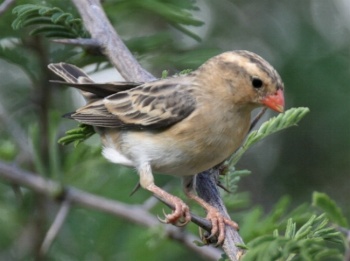(Added photo of female) |
(→Taxonomy: Update link) |
||
| (2 intermediate revisions by 2 users not shown) | |||
| Line 1: | Line 1: | ||
| − | [[Image:Queen_Whydah.jpg|thumb|550px|right|The tail of this male is not yet fully grown. <br /> Photo by {{user|Max+Holdt|Max Holdt}} <br /> | + | [[Image:Queen_Whydah.jpg|thumb|550px|right|The tail of this male is not yet fully grown. <br /> Photo by {{user|Max+Holdt|Max Holdt}} <br />Windhoek, [[Namibia]], February 2004]] |
'''Alternative name: Queen Whydah''' | '''Alternative name: Queen Whydah''' | ||
;[[:Category:Vidua|Vidua]] regia | ;[[:Category:Vidua|Vidua]] regia | ||
| − | |||
==Identification== | ==Identification== | ||
| − | + | Male<br /> | |
| + | '''Breeding''' | ||
| + | *Black crown and upperparts | ||
| + | *Golden breast | ||
| + | *Four elongated black tail shaft feathers with expanded tips. <br /> | ||
| + | '''Non-breeding''' loses the long tail and plumage changes to olive brown (similar to the female) | ||
==Distribution== | ==Distribution== | ||
Southern [[Africa]]: Southern [[Angola]], [[Namibia]], [[Botswana]], southern [[Zimbabwe]], northern [[South Africa]] and southern [[Mozambique]]. | Southern [[Africa]]: Southern [[Angola]], [[Namibia]], [[Botswana]], southern [[Zimbabwe]], northern [[South Africa]] and southern [[Mozambique]]. | ||
| − | [[Image:Shaft-tailed_Whydah_female_Max_Holdt_Windhoek_Namibia.jpg|thumb| | + | [[Image:Shaft-tailed_Whydah_female_Max_Holdt_Windhoek_Namibia.jpg|thumb|350px|right|Female <br />Photo by {{user|Max+Holdt|Max Holdt}} <br />Windhoek, [[Namibia]], November 2004]] |
==Taxonomy== | ==Taxonomy== | ||
| − | + | This is a [[Dictionary_M-O#M|monotypic]] species<sup>[[#References|[1]]]</sup>. | |
| + | |||
==Habitat== | ==Habitat== | ||
| − | Open habitats and | + | Open habitats, savanna and thornveld. |
==Behaviour== | ==Behaviour== | ||
| − | It is a brood parasite of the [[Common Grenadier]]. The diet consists mainly of seeds. | + | ====Breeding==== |
| + | It is a brood parasite of the [[Common Grenadier]]. | ||
| + | ====Diet==== | ||
| + | The diet consists mainly of seeds. | ||
| + | ==References== | ||
| + | #{{Ref-Clements6thDec09}}#Wikipedia | ||
| + | {{ref}} | ||
==External Links== | ==External Links== | ||
{{GSearch|Vidua+regia}} | {{GSearch|Vidua+regia}} | ||
[[Category:Birds]] [[Category:Vidua]] | [[Category:Birds]] [[Category:Vidua]] | ||
Latest revision as of 21:13, 11 July 2014
Alternative name: Queen Whydah
- Vidua regia
Identification
Male
Breeding
- Black crown and upperparts
- Golden breast
- Four elongated black tail shaft feathers with expanded tips.
Non-breeding loses the long tail and plumage changes to olive brown (similar to the female)
Distribution
Southern Africa: Southern Angola, Namibia, Botswana, southern Zimbabwe, northern South Africa and southern Mozambique.
Taxonomy
This is a monotypic species[1].
Habitat
Open habitats, savanna and thornveld.
Behaviour
Breeding
It is a brood parasite of the Common Grenadier.
Diet
The diet consists mainly of seeds.
References
- Clements, JF. 2009. The Clements Checklist of Birds of the World. 6th ed., with updates to December 2009. Ithaca: Cornell Univ. Press. ISBN 978-0801445019.
- Wikipedia
Recommended Citation
- BirdForum Opus contributors. (2024) Shaft-tailed Whydah. In: BirdForum, the forum for wild birds and birding. Retrieved 5 June 2024 from https://www.birdforum.net/opus/Shaft-tailed_Whydah





